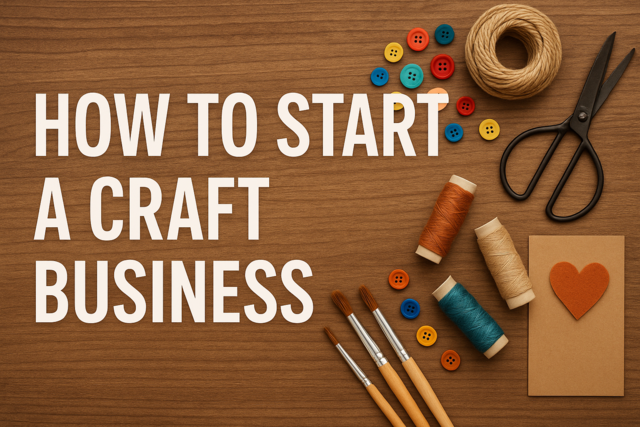You can create all the lovely crafts you want, but if you do not have anyone to sell them to, your business is not going to go very far. When creating a home-based craft business, you need to determine who will buy your crafts, and why. Take the time to identify your prospective customers, and where you will find them. Your customers can be individuals or businesses. You can sell your crafts at craft fairs, online, or as consignments. This article will give you a few ideas of how to determine your market, as well as how to best determine your potential earnings with your craft business.
Who Will Buy Your Crafts?
When you are busy creating a craft, do you think of where it will end up? Who is going to buy your craft, regardless of what it is? You need to ask yourself, or envision your potential customers. Your customers can be individuals, or they can be businesses that sell hand-crafted items. Your options are nearly limitless in finding customers, thanks to the global access provided by the Internet.
Not only do you need to figure out who you are going to sell your crafts to, you need to determine their likes and dislikes. If your crafts are useful and functional, what types of needs do they serve, or problems will they solve? For example, if you make bird houses or bird feeders, you will obviously be providing shelter and sustenance to birds. If you make dolls, you will make small children, and some adult doll collectors, very happy. Your crafts, whether they are developed for use, functionality, or design, will meet the needs, desires, and likes of many different individuals.
Who do you envision as your best customer? Children, teenagers, adults? If adults, are those adults younger, middle aged, or seniors? Do your best to identify your future customers and what motivates them, or will motivate them, to purchase your crafts.
Targeting Your Prospective Market
Before we get too far in determining a market for your crafts, remember that the reason you started your business, was because you enjoyed crafting. We want you to continue to enjoy crafting and creating works of art with your hands and creative skills. Once again, reflect on why you are opening your new business, and what you hope to achieve. If you merely want to share your skills and the pleasure you gain from your crafts with others, financial rewards may not be as important as other factors, including producing quality, long-lasting products that provide years of pleasure and enjoyment to others.
However, if you are going to make your crafting business succeed, you do have to take some time to understand customer desires and needs. A few steps can help you determine such needs, including:
- What age group are you going to initially target with your crafts? For example, which age group do you see benefiting, or being most interested in, the type of craft you produce?
- Test your potential products by asking friends and family members of different ages to rate your products in terms of interest. This way, you will be able to focus your crafting ideas to meet the needs of specific age groups, attitudes, and preferences.
- Ask friends or family members, or even your first clients, if they have suggestions or ways you can improve your crafts to ensure their marketability. For example, you may like bright, vibrant neon fabrics for your quilt, but others may find such colors unappealing. Determine which range of colors may appeal to the greatest range of individuals before spending the time it takes to create a quilt in order have that finished product appeal to more individuals.
- Take the time to research the potential demand or desire for the type of craft you are producing. For example, if you live in a desert mountain community, your business creating fishing lures may not be as lucrative as that same business located on oceanfront property could be.
Do your best to create a niche for yourself and create crafts that are not typically common in your neighborhood or community. For example, wicker or twig crafts are especially popular in areas like Tennessee, but are not so common in the western half of the U.S. Native American crafts may appeal to a broad range of people in all geographical areas, even overseas, so do a little homework and see what is popular out there. While you may not sell many of your twig crafts in your county, you may sell like crazy elsewhere. The same goes for antler crafts in Colorado. Antler crafts are very popular in the Rocky Mountain states, and may not have the same selling potential for a southern Californian, or someone from the eastern seaboard.
Keep your products unique and interesting. Take the time to visit a number of stores in your area to determine whether your craft, or type of craft, is easily purchased, or if you are able to offer a different take on crafts that are readily available.
You will also need to take the time to find out what crafts are popular at the moment. What was hot last year may not be marketable this year. Who is buying your crafts, and where are they most popular? Do your best to set yourself apart from others and create crafted products that have a wide appeal to the most age groups.
Remember that developing any business takes time, and that goes for a home-based crafting business. You may experience some fits and starts, some mistakes, and quite a few challenges. However, by carefully assessing the types of craft you choose, identify your target market, and the prospective desire for your specific crafts in that market, you will find yourself achieving the steady and growing clientele that soon extends beyond the borders of your neighborhood.
Conclusion
You can determine the interest, appeal and potential demand for your craft by participating in craft shows or fairs in your area. You may even start smaller, asking your friends and family members to take a look at your crafts, and determining appeal that way.
Remember that the most important aspect of starting a crafting business, is to identify who is going to buy your crafts. As you get started in your crafting business, you may need to develop a plan of action to help you stay on track with your goals. Many home crafters create a business plan, but unless you plan on expanding, and need loans to fund your business, a business plan is not always necessary.
Nevertheless, business and marketing plans are excellent ways to help you determine goals and achievements, and may help keep your business on track, organize your business efforts, and help you achieve your highest earning potential.
What About Marketing Basics?
Introduction
Most crafters starting a home-based business do not feel they need a business or marketing plan. While this is true, for the most part, a business plan does not need to be utilized solely to present to funders, lenders, or business partners. A business plan may also be designed to offer goals, milestones, or marketing potential and growth for your home-based business. While it is not mandatory, it certainly can not hurt to create at least a basic marketing plan to help guide the direction of your home-based craft business.
A traditional business plan can be created for your home-based craft business scenario. Because we certainly do not want to bore students with the long, drawn-out explanation of various aspects of marketing basics, we will just touch on topics of a marketing plan that might benefit you and your business, as you develop and grow.
Later on in this article, we are also going to discuss how you can determine your earning potential, both short-term and long-term.
A Brief Glimpse Into Business Plans
Traditionally, business plans are created to offer customers your mission statement, or your goals, regarding your business, as well as the type of products your business offers. Obviously, crafters will be able to offer a variety of crafted products for clients.
On top of that, traditional market plans offer an analysis that offers a focused glimpse at the target markets, or types of people you plan on selling your products to. This portion of the business plan is designed to anticipate future growth of your business, include information about possible competition, and a variety of marketing strategies you can employ for the growing success of your business.
Again, when you are first starting off with a home-based craft business, it is a good idea to know who your competitors are, but because crafts are so diverse in both style and construction, this is something you may not need to worry about, unless you decide to open a shop, or unless there is more than one social crafting group or guild in your area. If you realize there are four quilting groups in your neighborhood alone, you may want to find a unique quilting idea or angle before trying to market your quilts.
A business plan typically provides financial projections, or how much you plan on earning every month, on your business. The financial portion of a business plan will also include information regarding expenses and a profit and loss statement. Again, while you want to make money with your business, it is a good idea not to set your earnings potential or projections too high for at least the first year or two after opening a home-based craft business. If you make more than you planned, great. If not, you will not be disappointed. Remember, it takes time for any home-based business to get off the ground.
Home-based craft business owners need to give neighbors, friends, and surrounding communities time to get to know you, to realize your services are available, and to spread word of mouth regarding your business.
This brings us to the marketing strategies that you will use to broadcast your business. This part of a business plan is also known as management strategy. This portion of a traditional business plan explains what types of strategies or avenues you plan to take to market your business, grow your business, as well as how and when you plan to make these changes or growths.
Big or Small - A Marketing Plan Determines Where You Want to Go
Big or small, your craft business should have short-term and long-term goals in terms of earnings, growth, and future development. Again, the need to develop a marketing plan depends on what you are selling, how much of it you want to sell, and whether you have future plans for growing your business.
For those of you crafters who definitely want to grow their business, you need to have some kind of an idea of judging where your particular craft niche, or business, currently stands, where you would like to see it end up, and then plotting avenues or ideas on how to get there. The marketing plan is basically an outline of how you define the basic avenues or strategies, as well as costs, of how to get there.
For crafters, a marketing plan may be fairly simplistic. You start at Point A, and want to get to Point B. First, you need to consider a variety of questions.
- Ask yourself if you have any ideas about how you get from Point A to point B.
- Is it a matter of creating more product?
- Is it a matter of determining whether your crafts are priced too high, or too low?
- Do you need to spend more time marketing or advertising your products? For example, do you need to extend the demand for your craft beyond your immediate neighborhood, town, or county? Have you thought of ways to go national or even international?
- In order to help your business grow, you also need to determine costs versus revenues, the cost of packaging and mailing services, and the cost of your supplies.
Such questions should be developed into a marketing plan that you can understand and follow. You do not need to be formal when it comes to devising a marketing plan for personal use, and can even write it on a white board, a piece of legal paper, or save it as a Word document in your computer. Some form of a marketing plan is essential to anyone who wants to create a growing home-based business.
Determining Earning Potential
When determining your future earning potential, you also need to ask yourself some questions. For example, who are your best customers? Are they individuals, friends, or businesses? Do you see long-term sustainability with your crafts?
Are you capable and willing to take the time and effort to find new marketing avenues and sources for your crafts? This means marketing your crafts beyond your county line, state, or even country if necessary. The best way to do this is to determine what motivates your potential clients to buy your crafts.
When seeking a specific market, decide who you are going to target as primary customers. Show friends, family, or peers a sampling of your crafts and test your market. What was their reaction to your craft? Did they show satisfaction, pleasure, or just polite comments? Did you ask these people how much they would pay for such items?
By asking these questions, you will be able to determine how much your potential clients may be willing to pay for your craft, whether they would buy it in the first place, and whether or not they would purchase such items year round, for special occasions such as a birthday, or during the holiday season.
Whether or not you have decided to develop a marketing plan, a business plan, or simply of list of things you would like to accomplish with your home-based craft business, the first thing you need to do after completing those crafts, is to sell them.
























